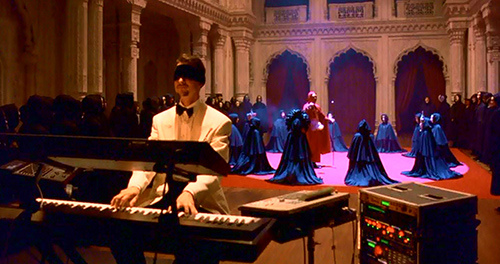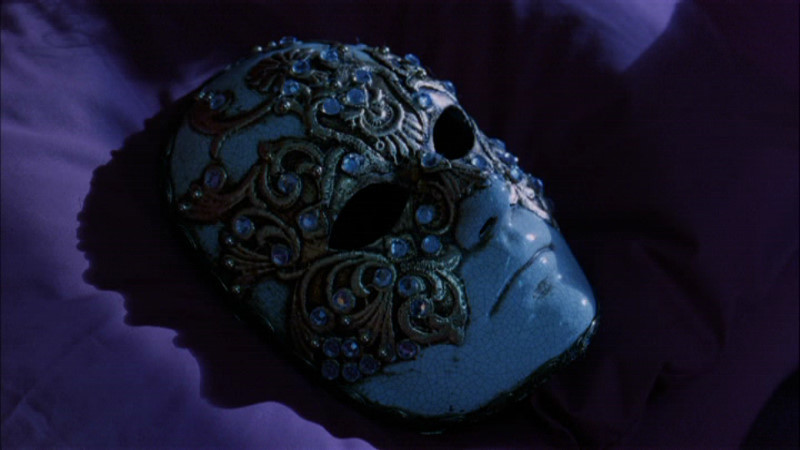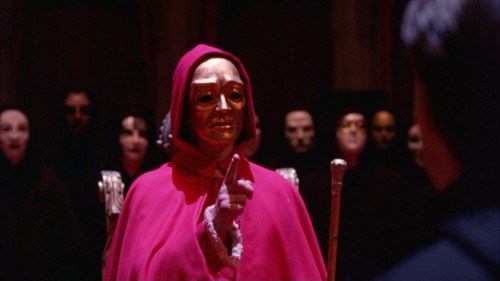
A memorable scene from Stanley Kubrick’s 1999 film Eyes Wide Shut finds Tom Cruise at the Rothschild mansion where he witnesses an elite sex-magick ritual set to a reverse Mass accompanied by live electric keyboard, because the Illuminati just gotta have that live keyboard sound; it makes the sex-magick nice and sexy. You can’t really perform a sex-magick rite without it. Electric keys are what the world leaders get down to each year at Bohemian Grove; the Presidential Emergency Operations Center located beneath the White House is cached with vintage casios in the event of a nuclear holocaust. For all their forward-looking empire-building-and-empire-destorying, the Powers That Be are still stuck in the ’80s with regards to their sex-magick soundtracks1.
Kubrick’s last film also features a colorful score of Shostakovich, Liszt, Chris Isaak, some jazz, and once the ritual is interrupted to kick Tom Cruise out of the MKUltra sex-magick party, the second half of the movie gets stuck on a simple piano piece—the second movement of Musica Ricercata by György Liget2.
Musica Ricercata II begins with 2 notes played in call and answer phrasing, E♯ and F♯, a semitone apart. Drag your mouse-hand from left to right along the noteheads below to hear the Musica. When you get to the end of the staff, return to the left and start again. Notice the visual symmetry in the 8 bar phrase.
It’s the perfect strolling music, especially if you’re stalking someone. The back and forth movement between the two neighboring pitches creates strong creeping tension when played in various octave combinations, and it isn’t gussied up with harmonies or any reference to a key; the melody is as butt-naked as a beta sex kitten3.

After repetition of the above phrase in eight wide octaves, a 3rd tone stalks the composition. A stark G is played and accelerated in accelerando. Throughout the film, the G is dropped at surprise moments, like when the protagonist Tom Cruise realizes that his wife Nicole Kidman has been participating in sex-magick rituals in her dreams, which is actually way worse.
The 3 tones that make up the piece, E♯. F♯, and G, are each a semitone apart. They create a dissonant chromatic tonality, an inherent ugliness that is rendered beautiful through a widening of the intervals, spread out over the octaves, and played on the soft pedal of the piano.
It would probably sound amazing on an electric piano keyboard.
György’s melody is used throughout Eyes Wide Shut as a leitmotif for the Illuminati presence in the film. The sexual tension of pretty much every character is echoed in the dissonant semitone intervals. The 3 tones (E♯, F♯, G) are right next to each other, the closest cluster of notes possible on a pianoforte, and yet they create the strongest dissonance, that’s only made pleasing by giving them some space; I think that’s a metaphor for love or something. The dance between the E-sharp and the F-sharp represents the tension between Tom and Nicole, back and forth they go, resolving on one and then the other. The sudden intrusion of the G tone plays on top of them, like the nefarious conspiracy that rules over our lives and seduces us with its ugly beauty.
Another interpretation: the doubling of the melody in a low and high octave represents two people—a man and woman—marching along a parallel path, and the conspiratorial tones that play between them, create even more dissonance in their lives, as they continue along with the same old melody, as if guided by the hidden hand.

Epilogue:
Stanley Kubrick is famous for filming the Apollo moon landings, which actually had some pretty good special effects for its day. Eyes Wide Shut was released on July 16, 1999, the 30th anniversary of the moon landing, five days after the movie was screened to Tom, Nicole, and Warner Bros. executives, and 666 days before January 1st of the New Year Y2K, Kubrick mysteriously died of a massive CIA heart attack gun. The end.
[2]
E♯ is also known as F♮, or it’s actually different, but it sounds the same. You may think E♯ is rather pretentious, or you may find the above score to be too fake bookish. So here’s the real score in the Youtube below. It’s in 5/4, though the pianist just kinda rests for an indeterminate amount of beats in between the phrases. 5/4 and E♯—now that’s double-dog pretentious and downright ostentatious.
[3]
For more on the subtext of this film, read the Greenbaum speech, or don’t, cause it’s horrifying.



